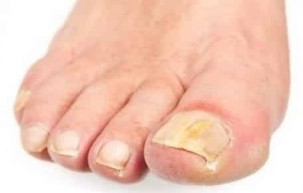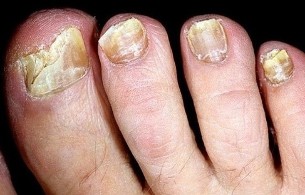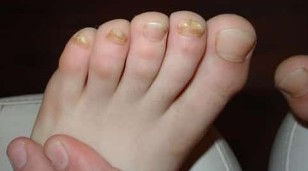Onychomycosis – is a pathology that destroys the nail plate. Fungus eats Keratin – construction base of the nail. The infection enters in the inter cellular space and begins its Division. In advanced stages of the pathology in the location of the touch on the skin of the feet, interdigital Zone, the heel is.

The reasons for toe nail fungus
By viruses, such as onychomycosis easy enough. The infection may be lurking on the beach, in public showers, sinks. High probability of catching of fungal-infected relatives or friends (joint use of resources of daily use).
There are a few important conditions to provoke the situation, the penetration of the Virus into the human body:
- weak immune system – reduction in the defense force as a result of the previous diseases of infectious or inflammatory in nature;
- Pathology of the blood vessels (blockage of the veins) functional disorders of internal organs (Diabetes mellitus), lead to problems with blood circulation in the lower extremities;
- minor damage to the skin on the feet (abrasions, cracks, corns, calluses), the wearing of tight shoes;
- diaper to ignore, dermatitis, and intense sweating of the lower extremities;
- the violation of measures of caution – try-on stranger's shoes, visiting public places without the slipper, and neglect of Hygiene of the feet.
Types of nail fungus
Onychomycosis, some species of fungi can provoke. Dermatophytes, manifest for example in the Form of opacities of the nail. Observed the formation of yellow spots on the edges or in the middle of the plate. In addition, longitudinal band along the affected area can.
Yeast fungus provokes a deformation of the nail plate. It is highly diluted, and starts from his place, to avoid the graying of the wood. The metabolism of the injured cells deteriorate, to nail the role furrows appear. In addition, on the adjoining Epidermis inflammation, swelling, redness, appears to be the disappearance of the nail observed in skin.
Types of fungus and bacteria can injure the nail plate, if you already have disease, eating disorders provoke nails. In this case, the turbidity of the plate occurs, you change your colour (from pale yellow and greenish to brown and even black).
To know the cause and the causative agent of negative changes in the skin and the nails should be, contact a professional. Stand-alone Definition of the disease and its treatment without consulting the doctor may have consequences.
The stage of the disease

Fungal infection of the nails affects healthy cells gradually. The disease has various stages of development, each of which is characteristic for your specific symptoms.
The first Phase of the onychomycosis (normotrofičeskaâ) has no signs of striking. In most cases, the response is hidden. The first signs of nail a little dimmed, changes its color, micro-cracks and yellow stains in the Form of circles or predilecta, hump appears. Beginners mushroom can be accompanied by itching and burning. Properly, the infection will detect in the initial phase is difficult, because the symptoms are similar as with other diseases (psoriasis, diseases of the liver).
To start, if timely treatment, the disease goes into the next Phase – hypertrophic. The nail is thicker, darker. The deformation of the plate, it is crumbling and destruction.
Launched in the Form of disease of the nails shows a strong thinning of the nail plate leads to its further separation. Loose-fitting skin is blue, and an unpleasant odor.
Symptoms
Onychomycosis usually affects the toenails, rarely the hands suffer. The disease begins with fingers and thumb (the outer edge of the affected), smooth all of the panels to beat.
To determine fungal infection, the leading symptoms of onychomycosis help:
- the formation of stripes and spots, whitish or green, can Be under the nails;
- Turbidity of the plate, change its color (from yellow to dark brown);
- Redness and flaking of the skin around the nail;
- the formation of bumps on the feet and between the toes;
- the formation of mold on the nails.
Species of fungus of the nails diseases
Onychomycosis categorize after the appearance of the person concerned. Since classification occurs one character, looks like fungus on the nails, it is differentiated into three types, depending on the clinical Manifestation:
- atrophic, or animalisticheskih – in which the nail plate is affected significantly by the degree of repulsion from the nail bed;
- hypertrophic type, in which the loser is changing in the natural Shine nail color (white, or Vice versa, it will be dark) and structure (a clear, thickened) with the advent of various types of deformations and even on the edges destroyed;
- normotroficheskie – look, characterized by the low degree of the lesion of the nail plate is not thickened, consistent, shiny and smooth, but still externally, its natural transparency, and color is transformed by the occurrence on it spots, marks and other visible changes.

Abroad, there is a further classification, according to which of the fungus on the nails is divided into types depending on the location of the lesion:
- in total, the disease-causing process by the whole of the nail plate;
- the distal shape of the lesion, containment only on the free edge of the nail extends beyond the fingers;
- the proximal, in which the edge of the plate, the break-under the nail fold (the opposite free edge of the nail!);
- the lateral shape of the lesion, effects on the sides of the nail plate.
How does pathology
Far, the population of fungal nail diseases an outward similarity to other dermatological disorders negribkovoy nature have spread. Depending on the stage of the pathology, start the nails, unhealthy appearance, since the natural Shine and transparency to lose. From the smooth and flat, they are thick and deformed, and with different colors (mostly white or dirty yellow) flower. The soft tissue around destructible parasite keratin layer is also inflammation involved, swelling and izyaslavs.
If it is a picture of the destruction of the nail plate perspective in the dynamics of the disease, then it is possible to a limited extent, divided into three successive stages:
- On the first level, almost no symptoms, except slight dullness, spots or streaks on the plate.
- On so-called serious Phase, quickly Start to change, all the symptoms of onychomycosis significantly.
- Phase – is the ultimate Degeneration of the nail, can be supplemented by the emergence of unpleasant smell of rotting.
Causes of the Deformation of the nail
Types of fungus, yeast-like fungi and fungi-dermatophytes cause infectious diseases of the nails (onychomycosis), manifested similar symptoms. All species of fungi on the nails of the feet or the hands, nail plate, deform, change their transparency, gloss, color. Changes in the nail are not only for onychomycosis, but also in case of injuries, chronic paronychia (inflammation of nail fold), psoriasis, eczema, brush, Dermatitis. To consider before a conclusion of infection, about fungus, you need to check all the possible options.
Symptoms of the fungus
There are different classifications of nail fungus-depending on the type of symptoms and they have completely different signs and symptoms, so it is important to determine (psoriasis, eczema, stop, versicolor and skin fungi are very similar). Superficial onychomycosis on the fingers is shown almost immediately after the infection, consider the symptoms and signs of mildew on the nails of the hands and feet:
- A thicker plate;
- Fragile, crumbling, or torn, the calendula not only in the vicinity of the edge, but also on the entire surface;
- Distorted shapes, rippled structure;
- The first Phase of the loss of luster and elasticity;
- If the nail is black (not in the bill, if the man regularly works with the color stocks, or mechanical parts);
- Nails pierce the skin;
- Infectious diseases of the intestine, perhaps the General decline in immunity, energy, light-headedness begins;
- Itching between the fingers and on the foot is particularly pronounced in children;
- Delamination from the nail bed, it is a very widespread phenomenon, and almost the last stage before the complete loss of the nail is called onycholysis. You may feel pain in the fingers and you discover a little unpleasant odor;
- The skin is dry, cracked, skin rash, and possibly even the occurrence of blood or ichor;
- Plesnewyj white or yellow dot under the nail, depending on the variety of the fungus, it is bright, dark can., with rounded edges and a cloudy structure

Before the start of the action you need to minimize the negative effects of the external environment, to eliminate the reasons why appeared to be the fungus under the nails of the feet:
- Warm and moist environment is ideal for the growth of various microorganisms, they try all the time after Hiking shoes to dry out, wear only socks made of natural materials, the normal heat and air exchange;
- Athlete's foot is often due to poor immunity, you can simply enter bare foot on the floor and catch an infection, to avoid this, take your vitamins;
- Common nail can be one of the reasons for the emergence of onychomycosis, limit the procedure up to 1 year;
- The hard-to-derivable, the fungus is by spores actively. They penetrate into the recesses between the nails and fingers can grow some time in the Phase of sleep, and according to dramatically. Most of them are stuck in the public areas (swimming-pools, shower cabins, solariums), during the operation of a strangers shoes, etc.
Common types of fungus Stop
There are many ways the infection by the fungus legs, but maybe it is only in direct contact with the pathogen. This most often occurs during the use of the stranger's shoes, or in case of violation of the rules of personal Hygiene. Fungus of the skin on the legs is shown in the rule by the destruction of the layer of the Dermis, this is reflected in the shape of the shell. Lesions of the Epidermis in this case, due to the fact that the infection penetrates in the deeper layers of the skin and destroy its structure.
Modern medicine differentiates between the following options fungal infection of the feet, each of which is characterized by its symptoms and treatment options:
- Athlete's foot InterDigital – the most common Form, shows in the Form of the disease. Symptom is usually localized in the gap between 3 and 4 fingers, and less often between 4 and 5, he looks like a Crack, covered covered with a white layer. From the indicated stratification of the Epidermis, the release of a certain amount of liquid, scaly borders, as well as the occurrence of symptoms of diaper rash may. Accompanied the characters interdigital fungus legs itching may be weak. This is the fungus can originally to the toes licking completely without symptoms, but in the future there is a substantial change in the structure of the skin.
- To distinguish fungal squamous cell carcinoma giperkineticeski from other species by the strong scale formation and cornification of the Epidermis. Characteristic of patients with various types of Dermatitis, preferably atopic. There is another type of the disease, after which you can clearly see, what mushrooms are on the legs. The main symptom of the disease – the emergence of erythema, painful pink nodules on the affected area has clear boundaries. Accompanied by a slight itching, cracks on the feet, dryness, pain, discomfort, yellow cover, and lesions of the nail plate. Onychomycosis, usually accompanied this type of fungus, can lead to a stratification of the nails;
- Mushroom bubble-shaped – one of the rare types of infections that the skin of the feet. Its name, the disease for the formation of the vesicles – vesicles with a liquid content on the site, then by Erosion, for dangerous infections. These are the symptoms that the fungus vesicules: the emergence of bubbles with a diameter of up to 1 centimeters, as well as a faint itch differs;
- Subclinical Fungal. In the initial phase, there is a small peel on the feet, but also the emergence of small cracks, externally, only the top layer of the Epidermis concern.
- Mushroom disgidroticheskaya, the infection occurs in the medical practice only in 8% of patients infected athlete. Is localized preferably in the sole and arch of the foot, manifested in the Form of bubbles, a merge gradually in, after which it will be a break with the subsequent formation of the Erosion of the large type. Risk of this type of mushroom is the possibility of joining of bacterial infections, because pathogens can easily penetrate ranku;
- Athlete's foot intertriginosny not themselves only, but also as an accompaniment squamous cell carcinoma Form of the fungus legs. Between the fingers of the holding, characterized by strong itching and burn, diaper dermatitis, and the occurrence of erosions;
- Onychomycosis – a more common variant of the defeat, the want of a nail fungus on the feet. Usually develops with a free edge of the nail plate, the first Phase is characterized by the appearance of yellow spots, the continued happening of the disease with lamination and full discharge of the nail. Often other forms of fungal infections accompanied;
- The Candida fungus, also called yeast-Erosion, localized in the interdigital space. In this case, the fungus on the legs looks like a concentration inflamed swollen areas of the skin, which may be surrounded gnojničkami referred to a small Form.

























